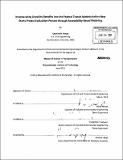| dc.contributor.advisor | Mikel Murga and Frederick P. Salvucci. | en_US |
| dc.contributor.author | Ducas, Caroline R. (Caroline Rose) | en_US |
| dc.contributor.other | Massachusetts Institute of Technology. Dept. of Civil and Environmental Engineering. | en_US |
| dc.date.accessioned | 2011-11-01T19:54:13Z | |
| dc.date.available | 2011-11-01T19:54:13Z | |
| dc.date.copyright | 2011 | en_US |
| dc.date.issued | 2011 | en_US |
| dc.identifier.uri | http://hdl.handle.net/1721.1/66861 | |
| dc.description | Thesis (S.M. in Transportation)--Massachusetts Institute of Technology, Dept. of Civil and Environmental Engineering, 2011. | en_US |
| dc.description | Cataloged from PDF version of thesis. | en_US |
| dc.description | Includes bibliographical references (p. 153-156). | en_US |
| dc.description.abstract | The Department of Transportation's announcement of the "Livability initiative" for major transit projects in January 2010 has prompted the Federal Transit Administration (FTA) to reassess the criteria used in the evaluation of New Starts projects. There is concern that the evaluation criteria for transit project benefits are too limiting and that not all project benefits are accounted for in the best way. Specifically, the FTA New Starts Program is beginning to shift away from the current measure of user benefits, a calculation of changes in mobility measured by hours of travel time saved, towards criterion based on the concept of livability. As of this writing, the FTA has yet to define livability and establish metrics that will be adopted in the next rulemaking process. This thesis evaluates the current FTA New Starts framework and presents an improved approach for measuring some of the livability benefits of transit projects through accessibility-based modeling. It is argued in this thesis that accessibility to essential services, such as employment, education, health care, and recreation, is a key component of livability. Furthermore, the concept of accessibility is both understandable and can be measured from existing data sources, and thus is an ideal building block from which to reconsider how transit project benefits should be evaluated in the New Starts process. Two transportation modeling software packages, TransCAD and Cube Voyager, are used to analyze the accessibility benefits of the MBTA Green Line Extension Project to illustrate the potential of accessibility measures in the project evaluation process. Findings suggest that gravity measures are more appropriate than isochrone measures when evaluating the accessibility benefits of proposed projects. The positive relationship between accessibility and mode share suggests that accessibility measures can serve as a valuable tool in the preliminary planning stages to quickly evaluate alternatives prior to the completion of a conventional four-step travel demand model and further justifies the use of accessibility measures in a livability-based project evaluation process. | en_US |
| dc.description.statementofresponsibility | by Caroline R. Ducas. | en_US |
| dc.format.extent | 175 p. | en_US |
| dc.language.iso | eng | en_US |
| dc.publisher | Massachusetts Institute of Technology | en_US |
| dc.rights | M.I.T. theses are protected by
copyright. They may be viewed from this source for any purpose, but
reproduction or distribution in any format is prohibited without written
permission. See provided URL for inquiries about permission. | en_US |
| dc.rights.uri | http://dspace.mit.edu/handle/1721.1/7582 | en_US |
| dc.subject | Civil and Environmental Engineering. | en_US |
| dc.title | Incorporating livability benefits into the Federal Transit Administration New Starts project evaluation process through accessibility-based modeling | en_US |
| dc.type | Thesis | en_US |
| dc.description.degree | S.M.in Transportation | en_US |
| dc.contributor.department | Massachusetts Institute of Technology. Department of Civil and Environmental Engineering | |
| dc.identifier.oclc | 758158702 | en_US |
